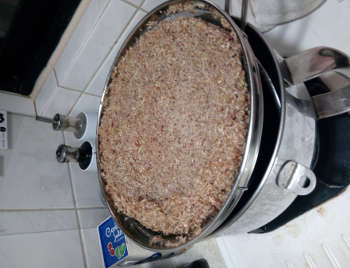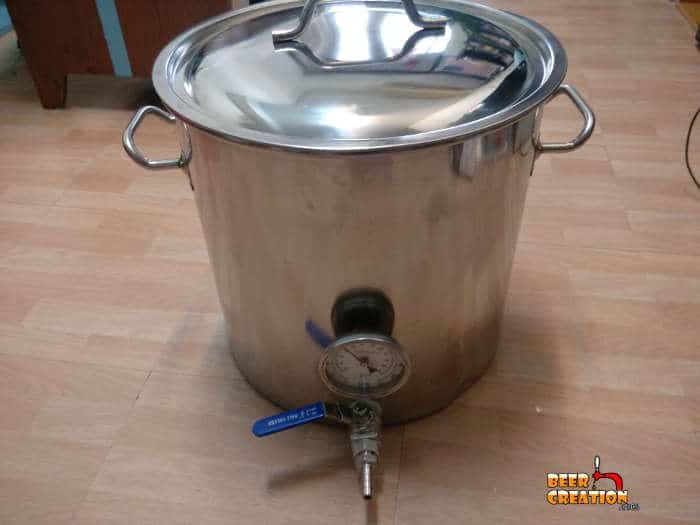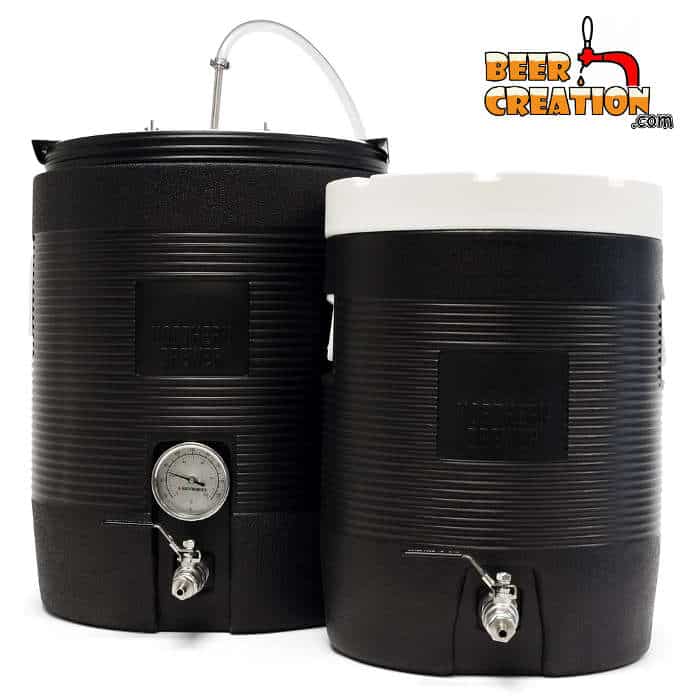When you are new to brewing beer at home there are so many terms which are thrown around, especially when it comes to pieces of equipment such as mash tuns and brew kettles.
Although home brewers are normally a very friendly bunch, except when you are asking if your fermenting beer looks infected or “how do I make non-alcoholic beer”, it’s sometimes daunting to ask these simple but essential questions.
With this being said, this article is to help you clearly understand the difference between a mash tun system and a brew kettle.
So, what exactly is the difference between a mash tun and a brew kettle?
A brew kettle is an essential piece of brewing kit for all brewers. Its purpose is to boil up wort which has been mixed with hops during ‘the boil’. A mash tun is a container only used by all-grain brewers & is used to activate enzymes in grains that break down starches to produce sugary wort.
If you want to find out exactly how each of these important pieces of kit is used, then please read on. I’ve got some great tips for what brew kettle or mash tun you need and even some alternatives to buying them.
A brief introduction to using a mash tun

If you are someone who is brewing for the very first time or even just doing some research before starting, you probably won’t need to worry about sourcing a mash tun just yet.
For most brewers, they begin their journey with an extract kit that they buy online or from the local brew shop. This is how I started and it’s a great way to get into this fantastic hobby.
Extract kits don’t require a separate container for mashing grains. However, many commercial kits these days do allow you to experience a semi-mashing process known as ‘steeping’. This is when you briefly allow a small amount of specialty malt grains found in your kit to infuse in some of your brewing water.
For the most part, however, your wort is created from pre-made liquid or dry Malt Extract (known as LME & DME) and in some cases, corn sugar. So, if this is the case for you, you can do this directly in your main brew kettle without the need for another container.
What is mashing?

Mashing is a process carried out by brewers who are following an all-grain recipe, either in a conventional way or using the BIAB method (check out my article on this beginner-friendly approach to all-grain brewing)
The idea is to soak malted grains in your strike water at around 150-155°F (65-68°C) which will animate naturally occurring enzymes in the grains. These enzymes then starting reducing the chemical makeup of starch found in the grain, converting it into fermentable sugar.
It is this sugar that makes brewing beer possible because without it the yeast we add to the wort, later on, would have nothing to convert into alcohol, which would be a sad day for any brewer.
After the grain has been mashed, it then needs to be washed and filtered so that we as brewers can extract the highest possible amount of fermentable sugars into our wort. This process is called lautering and, for most methods, requires another vessel to hold several gallons of sparge water. That extra container is called a hot liquor tank.
If you want to find out more about the lautering process, then you can check out my article on this topic which goes into more detail. I also have another article completely dedicated to the process of sparging, which is worth a read before you start brewing all-grain recipes.
New to homebrewing? Please feel free to read my ultimate guide to brewing beer at home and where to start.
A brief introduction to using a brew kettle
A brew kettle is perhaps the most used piece of kit by the brewing community and frankly, it would impossible to brew beer without one.
For extract kits, you mix your ingredients, such as LME and corn sugar, with any steeped specialty grains directly in your brew kettle. Basically, this is a stockpot or large metal container which you will heat your wort up in.
The boiling process involves several different processes, one of which you will be the busiest with is called the ‘brew day schedule’. This involves adding your hops bill to the wort at particular intervals during the boil. We do this at different times to reduce different levels of bitterness from hops into the wort. This helps balance out the sweetness of your beer and give it its distinct taste and aroma. (Shop for your hops online at homebrewing.org).
Other things which occur during the boil include the hot break which helps to reduce the protein levels in the finished beer as well as killing off any bacteria which may have gotten into the wort during mashing or steeping etc.
What type of brew kettle do you need?

Two of the most important thing to consider before using any vessel as your brew kettle are its size and its material.
An average yield for an extract kit will be around 5 gallons (19 liters) of beer. However, when you boil your wort you may be instructed to heat up anything from 2.5 gallons to 6.5 gallons of wort (10 -24 liters). It’s essential that your brew kettle is big enough to prevent any boilover.
Another thing to consider, especially if you are brewing in a conventional kitchen, is the material you are using. Although stainless steel is great because it’s easy to clean, hardwearing and cheap, it isn’t the best thermal conductor.
Aluminum is far better at absorbing heat and transferring it into the wort within. This is something which you may want to think about if your stove is not a particularly strong heat source. However, aluminum is, of course, more expensive than stainless steel these days.
Another couple of things to think about is how you will transfer your wort to your fermenter, so a built-in spigot may be helpful. Also, are you going to start out doing smaller batches only to quickly move on to brewing more beer? In which case, maybe it’s worth buying something bigger now so that you don’t have to reinvest your money later.
Luckily, I’ve gone into all these questions and given you lots of tips and my personal advice in another article dedicated to choosing the best possible brew kettle; you can check it out here.
What type of mash tun do you need?

Generally, for most brewers, you need a mash tun and lautering tun set up unless you are using the BIAB process which doesn’t require an extra mashing vessel.
Basically, you need an isothermic container which will keep the temperature of your strike water within the correct range during the entire mashing process. Although metal container can, in theory, be used, it’s far better to have an insulated vessel for larger batches of homebrew.
If you want to find out more about the type of mash tun I recommend, then please go over to my post here where I discuss everything you need to know.
Alternatives to consider
Let’s face it, homebrewing is a hobby which could rack up a huge bill if we let it. There are so many cool gadgets and labor-saving pieces of kit. If you have deep pockets, it doesn’t really matter, but for those of us brewing on a budget, it’s nice to know what we actually do need to fork out for.
Alternatives to expensive brew kettles
Without a doubt, you do need a brew kettle. It’s, as far as I know, impossible to boil wort without some sort of metallic pot. However, you don’t necessarily have to invest in, sorry to say it, an easier to use brew kettle with a built-in thermometer, spigot and whopping 10-gallon capacity (38 liters).
As I said, many of the extract kits you will come across will recommend a minimum boil quantity of around 2.5 gallons (10 liters). So, as long as you have a pot that can comfortably hold, say, 3-4 gallons (11-15 liters) you could just top up your fermenter with the additional water you need to reach your yield. This won’t affect the beer’s character as the ingredients in the kit were all calculated based on the batch’s yield.
Alternatives to fancy mash tun systems

As someone who has to brew in a fairly small galley kitchen in a modest apartment, I would say that if you have space and you are an avid beer fan, just invest in a decent mash tun system (including a hot liquor tank and sparge arm). It’s just going to save you time and frustration in the long term.
However, if you really do have a small budget but are good at making things, why not build your own DIY mash tun from a conventional cooler. They are designed to be isothermic and most come with an drainage system which could be converted into a handy spigot. You can also use a second cooler as a hot liquor tank.
Just be aware that a lot of the false bottoms I’ve seen for mash tuns are designed for circular vessels, so you may have to come up with your own system to create a good grain bed in your own DIY creation.




